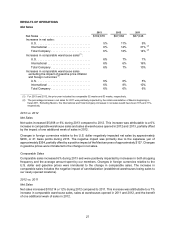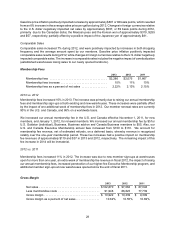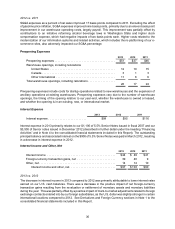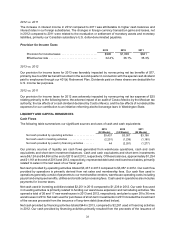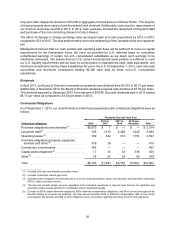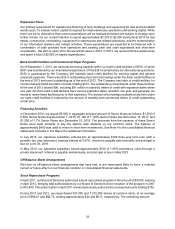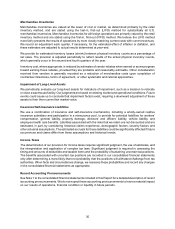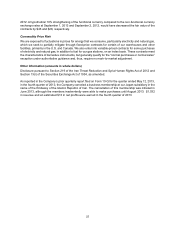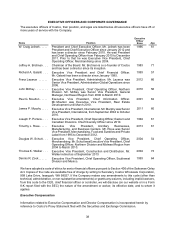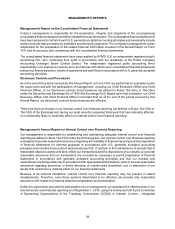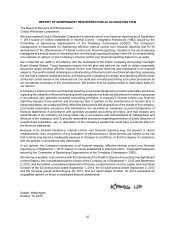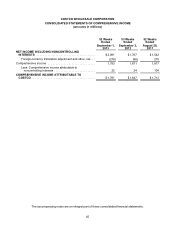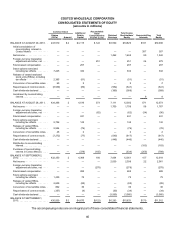Costco 2013 Annual Report Download - page 38
Download and view the complete annual report
Please find page 38 of the 2013 Costco annual report below. You can navigate through the pages in the report by either clicking on the pages listed below, or by using the keyword search tool below to find specific information within the annual report.36
Quantitative and Qualitative Disclosures About Market Risk (amounts in millions)
Our exposure to financial market risk results from fluctuations in interest rates and foreign currency exchange
rates. We do not engage in speculative or leveraged transactions or hold or issue financial instruments for
trading purposes.
Interest Rate Risk
Our exposure to market risk for changes in interest rates relates primarily to our investment holdings that
are diversified among various instruments considered to be cash equivalents as defined in Note 1 to the
consolidated financial statements included in this Report, as well as short-term investments in government
and agency securities, and corporate notes and bonds with effective maturities of generally three months
to five years at the date of purchase. The primary objective of our investment activities is to preserve principal
and secondarily to generate yields. The majority of our short-term investments are in fixed interest rate
securities. These securities are subject to changes in fair value due to interest rate fluctuations.
Our Board of Directors have approved a policy that limits investments in the U.S. to direct U.S. government
and government agency obligations, repurchase agreements collateralized by U.S. government and
government agency obligations, and U.S. government and government agency money market funds. Our
wholly-owned captive insurance subsidiary invests in U.S. government and government agency obligations,
corporate notes and bonds, and asset and mortgage-backed securities with a minimum overall portfolio
average credit rating of AA+.
Our Canadian and other international subsidiaries’ investments are primarily in money market funds, bankers’
acceptances, bank certificates of deposit and term deposits, generally denominated in their local currencies.
We performed a sensitivity analysis to determine the impact that a 100 basis-point change in interest rates
would have on the value of our investment portfolio. At the end of 2013 and 2012, the incremental change
in the fair market value was immaterial. For those investments that are classified as available-for-sale, the
unrealized gains or losses related to fluctuations in market volatility and interest rates are reflected within
stockholders’ equity in accumulated other comprehensive income.
The nature and amount of our long-term debt may vary as a result of future business requirements, market
conditions and other factors. As of the end of 2013, the majority of our long-term debt is fixed rate Senior
Notes, carried at $4,595. Fluctuations in interest rates may affect the fair value of the fixed-rate debt and
may affect the interest expense related to the variable rate debt. See Note 4 to the consolidated financial
statements included in this Report for more information on our long-term debt.
Foreign Currency-Exchange Risk
Our foreign subsidiaries conduct certain transactions in their non-functional currencies, which exposes us
to fluctuations in exchange rates. We manage these fluctuations, in part, through the use of forward foreign-
exchange contracts, seeking to economically hedge the impact of fluctuations of foreign exchange on known
future expenditures denominated in a non-functional foreign-currency. The contracts are intended primarily
to economically hedge exposure to U.S. dollar merchandise inventory expenditures made by our international
subsidiaries whose functional currency is other than the U.S. dollar. Currently, these contracts do not qualify
for derivative hedge accounting. We seek to mitigate risk with the use of these contracts and do not intend
to engage in speculative transactions. These contracts do not contain any credit-risk-related contingent
features.
We seek to manage counterparty risk associated with these contracts by limiting transactions to
counterparties with which we have established banking relationships. There can be no assurance, however,
that this practice effectively mitigates counterparty risk. These contracts are limited to less than one year in
duration. See Note 1 and Note 3 to the consolidated financial statements included in this Report for additional
information on the fair value of open, unsettled forward foreign-exchange contracts at the end of 2013 and



